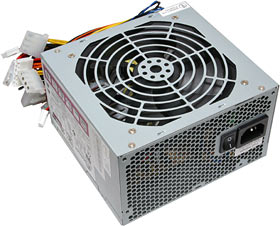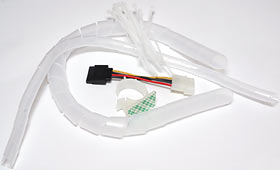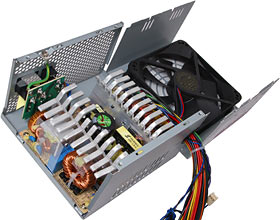
Seasonic Super Tornado SS-400FB Power Supply Unit
Review date: 5 March 2004. Last modified 03-Dec-2011.
There seem to be three basic things you can do to make a marketable PC Power Supply Unit (PSU) today.
One: You can make it cheap, cheap, cheap. The low price point for allegedly-300-watt PSUs, these days, is below $US15. If you're thinking that doesn't sound like a recipe for quality, you're right.
Two: You can make it a solid, genuine product that actually does the job well, and should continue to do so for many years.
Three: You can dress the thing up like a twenty dollar hooker. Anodised heat sinks, lacquered enclosures, LED-lit fans, clear plastic windows, bells, whistles and gongs.
The latter two courses are not mutually exclusive. Just because a PSU is brightly coloured does not mean it's rubbish. A show-off PSU is probably not going to be an ironclad By Appointment To Skynet mission-critical-server product, but neither are most grey-box PSUs, and that's perfectly OK. There are lots of show-off PSUs out there that're more than adequate to the task of running a home PC. If you're nervous about being left computerless late on a Friday evening, buy two PSUs and put one on the shelf for emergency replacement duty. You'll probably be fine; PSUs that die don't usually do so in such a way as to damage the computer they're powering.
This is a PSU that, as far as I can see, is all about strategy two.
Seasonic's PC PSUs aren't ludicrously expensive, but neither are they dirt cheap. This model, the Super Tornado SS-400FB, can be had for around $US100 (there are some cheaper dealers, as I write this, but I doubt their sincerity), which is in line with the pricing for various show-off lacquer-and-anodising 400 watt PSUs.
This, though, is not a show-off PSU. It's got a big ass fan, to be sure, and an all-grille back panel to let the fan's air flow out, but that's it for fancy visual features. It's plain grey steel, the fan's black and unlit, and the heat sinks inside are boring bent aluminium, not even cast, much less gold and shiny.
There's no fan speed knob, no external four pin socket for running god-knows-what outside your computer case, no cigarette lighter, no fishnet-clad silicone-insulated Day-Glo wire bundles, no electric cat toy.
Instead, this "Super Tornado" PSU (PDF info sheet here) is all go, and no show.
PSU spec labels tell you more than just the raw current figures for the different rails. They actually provide a decent guide to the overall quality of an unknown PSU. If the label on the side doesn't make sense, or doesn't tell you everything it ought to, then you're probably looking at a lousy PSU.
This is a decent label. Partly because it's got about three hundred approval glyphs on it, and partly because it breaks down the rail ratings by aggregate total - 92.4 watts for +3.3V by itself, 150 watts for +5V by itself, but only 200 watts for both together. Another 264 watts for the +12V rail, and the usual minor extras for the -12V and 12V standby rails (9.6 and 10 watts, respectively), but only 400 watts for everything together. The substantial margins by which the individual positive rail ratings exceed the aggregate ratings (add the +3.3, +5 and +12V individual ratings and you get more than 500 watts) are a sign of a quality PSU.
Unusually, this PSU doesn't have a -5V rail at all (which gave this thing a chance to light its red LED). There is no white -5V wire going to pin 18 of the ATX plug; that pin's left unconnected.
This is OK, though. -5V is used by pretty much nothing any more. As of v1.2 of the ATX12V specification, PSUs haven't been required to have -5V output. Modern PCs will never miss it.
As well as an ATX, an ATX12V and a seldom-used-by-desktop-computers AUX connector, the SS-400FB gives you eight four-pin "Molex" drive power plugs, and two floppy power plugs (just as likely to be used as video card power plugs, nowadays).
My only complaint about this cabling is that it's not tremendously long. Six of the drive power plugs are split between two leads that end in floppy plugs; the furthest of the plugs stretches little more than 70cm from the PSU. This'll be more than enough for most cases, but big tower enclosures may need more, as will people with a cable tidying fetish.
There are lots of PSUs that only give you about this much wire. More than 80cm of cable to a drive plug is quite unusual, and the more wire there is the more voltage drop there'll be along it. But I still wouldn't have minded seeing a little more.
The PSU's cable bundle also includes a lead terminating in a three-pin fan plug, to connect to your motherboard if you want to monitor the speed of the PSU's 120mm fan. The fan's thermally controlled; at minimum speed it's nearly silent - and driven so gently that it's possible to stop it with a finger and have it not be able to start itself again. In the real world, this is unlikely to be a problem; the fan probably won't get jammed at all, and it'll usually be running faster than minimum speed.
Like this shinier PSU with a 120mm fan, the Seasonic moves enough air to keep itself cool, but won't make much of a contribution to total case airflow, unless the case is really warm and the fan winds up to full power. It's built for quietness, not case ventilation. It'd probably cut it by itself in a basic business box, though.
Along with the PSU, you get the usual ATX cable (not shown), a four-pin-to-SATA drive power adapter, a couple of spiral-wrap plastic cable bundlers, and a collection of nylon cable ties. This stuff can all be easily bought by dedicated geeks for not much money, but it's still nice to see such little extras as standard equipment.
Inside, the Seasonic's downright bland. Solid, well built...
...but definitely not worth modding a window into.
Those boring heat sinks are right above the cooling fan, though (the fan should face downward when the PSU's installed; it's apparently designed to last a long, long time with its bearing hanging like that), and no other component's in the wind-shadow of anything else.
These innards are more technically than aesthetically interesting. This PSU can manage, according to the manufacturer, up to 80% overall efficiency, which won't make a lot of difference to your electricity bill, but will reduce the amount of heat the PSU has to get rid of, compared with less efficient PSUs.
The PSU also features active Power Factor Correction (PFC), which Seasonic say will considerably reduce your power bill.
Well, it will if you're billed by apparent power; it won't if you're not. Most domestic and small business power consumers won't see any advantage. Quite a few countries are now enacting legislation to require good power factors in new equipment, but it's not something that's likely to be of much interest to consumers. I talk about all this in detail here.
The SS-400FB's circuit is a "forward converter" design, instead of the more common half bridge. This should, as Seasonic say, make the PSU more reliable, all things being equal. But I haven't got an MTBF lab and a few months handy to find out for sure.
All this clever circuitry, of course, means that this is an "all voltage" PSU; it'll run from anything between 100 and 240 volts AC, without any manual switching. People in 220V countries who enjoy clicking PSUs into 110V mode and waiting for a victim to turn the computer on have fewer and fewer opportunities to do so, these days.
Overall
When people ask me what PSU they should buy, I establish whether they're looking for something funky, and if they're not I then tell them to buy a nice boring grey steel box with a big-brand sticker on the side. AOpen PSUs are a good bet here in Australia, for instance, but certainly not the only option.
I'm now quite ready to add Seasonic to my list of recommendations - though not for Australian buyers, since nobody seems to sell their PSUs here.
I haven't tested this PSU for long enough to make any rock solid comments about its quality or reliability, but all the signs are right. As is the price, and the build quality, as far as I can see.
I'd be happy to use an SS-400FB in my own PC. Recommended.
Review PSU kindly provided by Seasonic.







